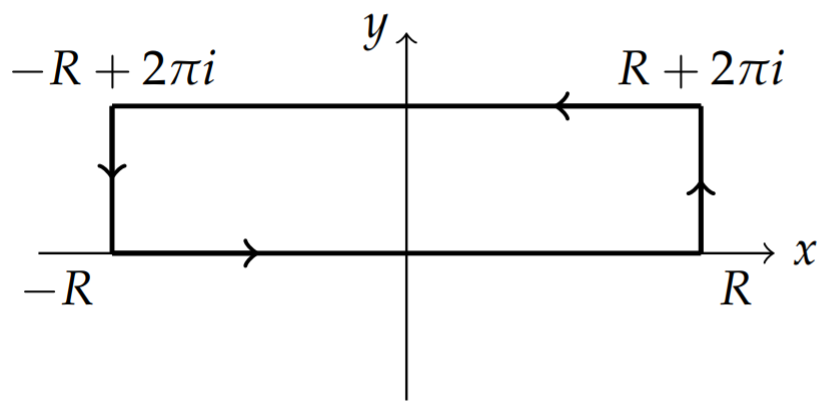8.7: Problems
( \newcommand{\kernel}{\mathrm{null}\,}\)
Write the following in standard form.
- (4+5i)(2−3i).
- (1+i)3.
- 5+3i1−i.
Write the following in polar form, z=reiθ.
- i−1.
- −2i.
- √3+3i.
Write the following in rectangular form, z=a+ib.
- 4eiπ/6.
- √2e5iπ/4.
- (1−i)100.
Find all z such that z4=16i. Write the solutions in rectangular form, z=a+ib, with no decimal approximation or trig functions.
Show that sin(x+iy)=sinxcoshy+icosxsinhy using trigonometric identities and the exponential forms of these functions.
Find all z such that cosz=2, or explain why there are none. You will need to consider cos(x+iy) and equate real and imaginary parts of the resulting expression similar to problem 5.
Find the principal value of ii. Rewrite the base, i, as an exponential first.
Consider the circle |z−1|=1.
- Rewrite the equation in rectangular coordinates by setting z= x+iy.
- Sketch the resulting circle using part a.
- Consider the image of the circle under the mapping f(z)=z2, given by |z2−1|=1.
- By inserting z=reiθ=r(cosθ+isinθ), find the equation of the image curve in polar coordinates.
- Sketch the image curve. You may need to refer to your Calculus II text for polar plots. [Maple might help.]
Find the real and imaginary parts of the functions:
- f(z)=z3.
- f(z)=sinh(z).
- f(z)=cosˉz.
Find the derivative of each function in Problem 9 when the derivative exists. Otherwise, show that the derivative does not exist.
Let f(z)=u+iv be differentiable. Consider the vector field given by F=vi+uj. Show that the equations ∇⋅F=0 and ∇×F=0 are equivalent to the Cauchy-Riemann equations. [You will need to recall from multivariable calculus the del operator, ∇=i∂∂x+j∂∂y+k∂∂z.]
What parametric curve is described by the function
γ(t)=(t−3)+i(2t+1),
0≤t≤2 ? [Hint: What would you do if you were instead considering the parametric equations x=t−3 and y=2t+1 ?]
Write the equation that describes the circle of radius 3 which is centered at z=2−i in a) Cartesian form (in terms of x and y ); b) polar form (in terms of θ and r ); c) complex form (in terms of z,r, and eiθ ).
Consider the function u(x,y)=x3−3xy2.
- Show that u(x,y) is harmonic; i.e., ∇2u=0.
- Find its harmonic conjugate, v(x,y).
- Find a differentiable function, f(z), for which u(x,y) is the real part.
- Determine f′(z) for the function in part c. [Use f′(z)=∂u∂x+i∂v∂x and rewrite your answer as a function of z.]
Evaluate the following integrals:
- ∫Cˉzdz, where C is the parabola y=x2 from z=0 to z=1+i.
- ∫Cf(z)dz, where f(z)=2z−ˉz and C is the path from z=0 to z=2+i consisting of two line segments from z=0 to z=2 and then z=2 to z=2+i.
- ∫C1z2+4dz for C the positively oriented circle, |z|=2. [Hint: Parametrize the circle as z=2eiθ, multiply numerator and denominator by e−iθ, and put in trigonometric form.]
Let C be the positively oriented ellipse 3x2+y2=9. Define
F(z0)=∫Cz2+2zz−z0dz.
Find F(2i) and F(2). [Hint: Sketch the ellipse in the complex plane. Use the Cauchy Integral Theorem with an appropriate f(z), or Cauchy’s Theorem if z0 is outside the contour.]
Show that
∫Cdz(z−1−i)n+1={0,n≠02πi,n=0
for C the boundary of the square 0≤x≤2,0≤y≤2 taken counterclockwise. [Hint: Use the fact that contours can be deformed into simpler shapes (like a circle) as long as the integrand is analytic in the region between them. After picking a simpler contour, integrate using parametrization.]
Show that for g and h analytic functions at z0, with g(z0)≠0,h(z0)=0, and h′(z0)≠0,
Res[g(z)h(z);z0]=g(z0)h′(z0).
For the following determine if the given point is a removable singularity, an essential singularity, or a pole (indicate its order).
- 1−coszz2,z=0.
- sinzz2,z=0.
- z2−1(z−1)2,z=1.
- ze1/z,z=0.
- cosπz−π,z=π.
Find the Laurent series expansion for f(z)=sinhzz3 about z=0. [Hint: You need to first do a MacLaurin series expansion for the hyperbolic sine.]
Find series representations for all indicated regions.
- f(z)=zz−1,|z|<1,|z|>1.
- f(z)=1(z−i)(z+2),|z|<1,1<|z|<2,|z|>2. [Hint: Use partial fractions to write this as a sum of two functions first.]
Find the residues at the given points:
- 2z2+3zz−1 at z=1.
- ln(1+2z)z at z=0.
- cosz(2z−π)3 at z=π2.
Consider the integral ∫2π0dθ5−4cosθ.
- Evaluate this integral by making the substitution 2cosθ=z+1z, z=eiθ and using complex integration methods.
- In the 1800’s Weierstrass introduced a method for computing integrals involving rational functions of sine and cosine. One makes the substitution t=tanθ2 and converts the integrand into a rational function of t. Note that the integration around the unit circle corresponds to t∈(−∞,∞).
- Show that
sinθ=2t1+t2,cosθ=1−t21+t2.
- Show that
dθ=2dt1+t2
- Use the Weierstrass substitution to compute the above integral.
- Show that
Do the following integrals.
- ∮|z−i|=3ezz2+π2dz
- ∮|z−i|=3z2−3z+4z2−4z+3dz.
- ∫∞−∞sinxx2+4dx
[Hint: This is Im∫∞−∞eixx2+4dx.]
Evaluate the integral ∫∞0(lnx)21+x2dx.
[Hint: Replace x with z=et and use the rectangular contour in Figure 8.7.1 with R→∞.]

Do the following integrals for fun!
- For C the boundary of the square |x|≤2,|y|≤2,
∮Cdzz(z−1)(z−3)2.
- ∫π0sin2θ13−12cosθdθ.
- ∫∞−∞dxx2+5x+6.
- ∫∞0cosπx1−9x2dx
- ∫∞00dx(x2+9)(1−x)2
- ∫∞0√x(1+x)2dx
- ∫∞0√x(1+x)2dx


